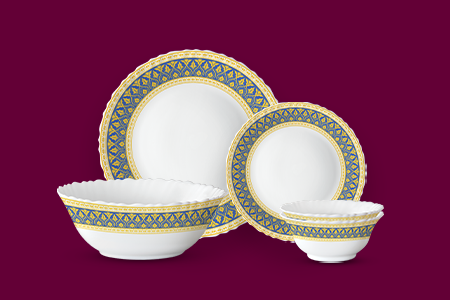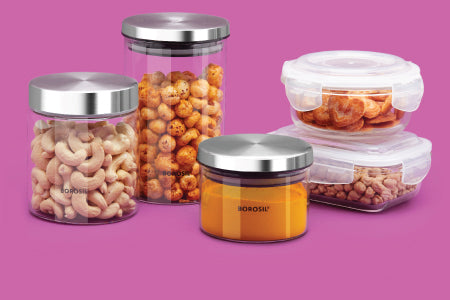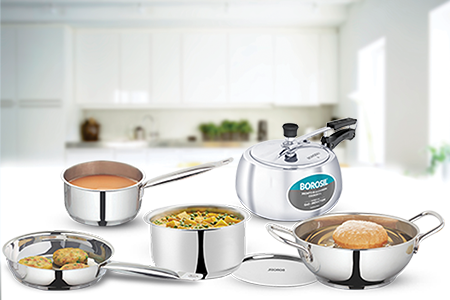
Croissant Recipe
Learn the Art of Croissant Making Today!
Flaky, buttery crescent-shaped pastry... is there really anything better than that? Plus, it looks nothing less than a piece of art and melts in your mouth - that's a croissant for you! Thanks to social media, this French delicacy has taken the world by storm, with a plethora of mouthwatering variations constantly popping up!

You don't have to jet off to France or scour your neighbourhood for an authentic bakery. Why? Because you can whip up these delectable treats right in your own kitchen! While some may believe mastering the art of croissant making requires the skills of a seasoned baker or pâtissier, fear not. We've got a foolproof recipe just waiting for you!
Homemade Croissant Recipe
How do I make croissants? We have broken down the croissant recipe into a few easy-to-follow steps.
Croissant Ingredients
You can make 10 large or 12 medium croissants with the following measurements.
Gather the following ingredients for the dough for this bread croissant recipe:
• Active dry yeast - 4 and 1/2 teaspoons
• Lukewarm water - 1 cup
• Bread flour - 3 and 1/2 cups (all-purpose flour will work, but there's a tiny catch)
• Granulated sugar - 1/4 cup
• Salt - 2 teaspoons
• Softened butter - 6 tablespoons
• Milk - 2 tablespoons
For lamination or shaping of the layers:
• Softened or room-temperature butter - 1 cup (2 sticks)
• Milk - 2 tablespoons
• Maple or agave syrup - 1 tablespoon
Alternative for Vegan Croissant Bread
How do you make a croissant vegan? Just alternate the following options.
• Vegan butter instead of dairy butter
• Non-dairy milk instead of regular milk
Step 1: Make the Dough for the Croissants

You can make the croissant dough by hand or in a stand mixer. In any case, pour lukewarm water into the mixing bowl. Sprinkle the dry yeast and let it proof until it looks bubbly. It will take 5 to 10 minutes. Add the granulated sugar, flour, salt and soften butter. Mix the dough by hand or using a spatula. When it all comes together in a rough ball, shift it onto a floured board or countertop and knead as you will any bread dough. It should look smooth and bounce back when poked.
You can stretch a small portion of the dough to see if you can see the light through it. If it starts to tear, put it back on the mixer for another couple of minutes.
When using a stand mixer to make the croissant dough, start with the paddle attachment and knead the dough at medium speed; it should form a ball. Replace the paddle with the hook attachment and knead for another 8 to 10 minutes until the dough is nice and smooth.
If you use all-purpose flour, add a little extra flour in tiny batches.
Step 2: Rest the Dough

Transfer the croissant dough to a greased bowl, cover it with a cloth, and place it in a warm corner. Depending on the temperature, it will take 1 to 2 hours or longer.
Once risen, uncover the bowl, punch the dough, and transfer to a lightly floured countertop or surface. Roughly fold it into a rectangle. It doesn't need to be neat since you will roll it out later. Wrap the dough in plastic or place it in a sealed container, and put it in the fridge. Ideally, it is better to rest the dough overnight.
That said, 30 minutes in the fridge will also do!
Step 3: Form the Butter Slab

Place one cup of softened butter on a piece of plastic, cover it with another, and roll it out to form a small square shape (6"x6"). You can use a square ziplock bag and spread it using your hand or a spatula. Put the butter slab into the fridge overnight or until it hardens.
Step 4: Laminate the Dough, i.e., Make the Layers

Place the chilled croissant dough on a floured surface, apply some flour on a rolling pin, and start rolling the dough in a large rectangular shape. It should be 8"x16" roughly or able to cover the entire slab of butter while leaving some space on the edges. Put the chilled butter slab on one side of the rolled dough, fold the other sides over, pinch the edges to seal the butter, and roll out. Don't forget to sprinkle the surface and rolling pin with some flour so the dough doesn't stick.
Now, perform a double turn. Fold two sides of the dough so they meet in the middle and then fold them one more time to create four layers.
Chill the dough, roll it out, repeat the double turn, and put it back in the fridge for another hour. The key here is to harden the butter each time before rolling so it doesn't ooze out or ruin the shape.
Step 4: Shape the Croissant

Cut half of the chilled dough, sprinkle some flour, and roll it, maintaining a rectangular shape. Use a knife or pizza cutter and cut corner to corner to create 5 or 6 triangle pieces, depending on the size of croissants you want. Push the base upwards and roll gently to get the famous crescent shape! Make another batch of croissants with the remaining half of the dough.
Want a Chocolate Croissant?

Oh, the classic pain au chocolat! Instead of triangles, cut the dough into smaller rectangles, place a piece of chocolate, and roll from one side to another.
Step 5: Bake the Croissant

How to bake a croissant? Preheat the oven for a few minutes to 400°F (205°C). Brush the croissants with the milk and maple or agave syrup. Bake for 10 minutes at 400°F (205°C) followed by another 12 to 15 minutes at 350°F (176°C).
The result should be golden, crispy and shiny croissants.
As hard as it is to wait ding in, allow the croissants to sit for 5 minutes on the baking tray and then transfer to the cooling rack for a while!
Conclusion
Once your croissants are baked, your kitchen will be filled with the smell of fresh buttery delight, and you will have a tray of warm happiness to dig in!





















